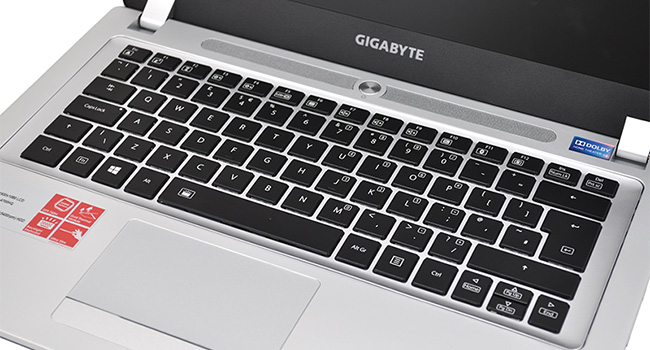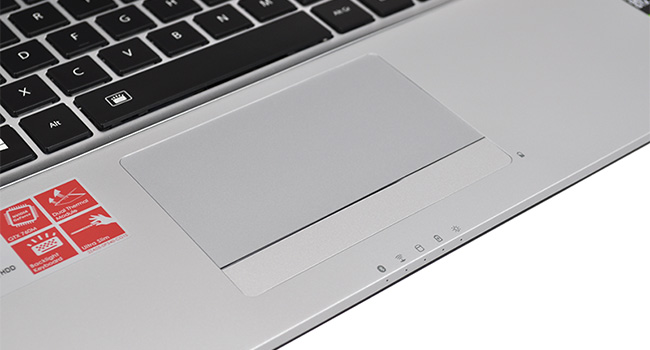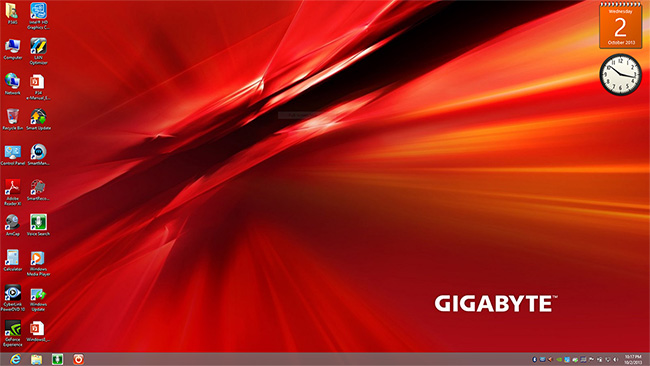Keyboard and Trackpad
We've seen our fair share of gaming laptops that pile in performance and eschew must-have additions such as enjoyable displays and comfortable keyboards. Gigabyte isn't making that mistake, and builds on the promise of the AHVA display with a keyboard that's decent, too.
Overall layout is good, the chiclet keys are well-sized and well-spaced, and for gamers, the Windows key can be disabled through software. It's a keyboard that's easy to get used to, and users will appreciate the fact that the entire panel is backlit, with the option to adjust brightness manually or automatically through an ambient light sensor.
Unfortunately for Gigabyte, our day-to-day laptop is a ThinkPad, and though the P34G keyboard is decent, it's not able to compete with the best boards currently on the market. Compared to a ThinkPad, the keys feel a little loose and lifeless, and though the underlying tray is aluminium, it isn't entirely flex-free - you can't help but notice a bit of give when you press the power button.
Accompanying the keyboard is a nice, large Elan trackpad that feels comfortable to the touch and responds well to various Windows 8 gestures. The touch surface is the pad's strong point, as the accompanying rocker button isn't quite as good. There's a small dead spot between the left and right clicks, and the build material isn't up to the standards set by the rest of the chassis - the rocker feels thin and doesn't press evenly throughout.
Software
It's clear that Gigabyte is intent on improving the user experience, and nowhere is that more obvious than with the company's software configuration. Bloatware is kept to a minimum, with the 64-bit installation of Windows 8 layered only with a couple of inoffensive additions.
We'd like to see less clutter on the desktop, but most of the items are designed to make it easier for users to get to grips with Windows 8. Gigabyte includes shortcuts to common functions such as Windows Media Player and Windows Update, and continues to bring the old Windows Sidebar out of retirement.
The company's SmartUpdate and SmartManager utilities are on hand and make it easy to find the latest drivers and control popular settings such as display brightness, and the only questionable addition is CyberLink PowerDVD - for those longing for an optical drive, it will only add insult to injury.
It's important that Gigabyte keeps the 128GB SSD as clean as possible, yet the relatively-light software setup still takes its toll as users are left with roughly 50GB of free space on the system disk. Digging deeper reveals that the recovery partition is partially to blame - it alone consumes 20GB, and though we appreciate having it available, we'd prefer to see it reside on the hard disk.
Heat and Noise
Would it surprise you to know that the P34G runs cool and quiet? It certainly did us. During regular use, we found the fans would keep reasonably quiet and CPU temperature would remain below 50ºC.
That's miraculous for a quad-core 47W chip, but further investigation reveals what's really going on. It turns out Gigabyte intentionally limits CPU performance when the laptop is running on battery, and by a significant amount. Plug the P34G into the mains and the Core i7-4700HQ will ramp up to 3.4GHz. When on battery, the chip doesn't go beyond 1.3GHz - that's a massive 60 per cent reduction, and as a consequence the laptop can feel sluggish when it isn't mains powered.
There are advantages - namely power efficiency, temperature and noise; all of which benefit from the reduced clock speed - but the performance gap is too large for our liking. You can certainly feel the difference when you're running on battery.
Gigabyte is obviously concerned about battery life - and you'll see why later in the review - but this configuration means that users will need to use the bundled power adapter to get the most out of the laptop's underlying hardware. The good news is that when plugged-in, the P34G doesn't run into throttling issues. During our benchmarks we recorded CPU temperatures of around 80ºC, which is well within the limits of the machine, though at this point the laptop does become noisy as the fans kick in to top gear.












